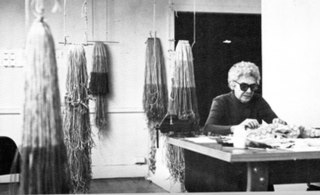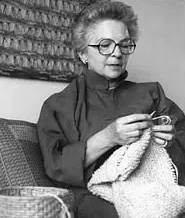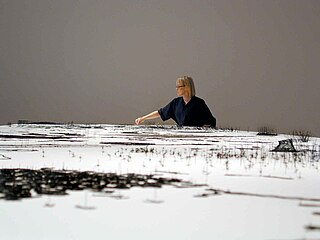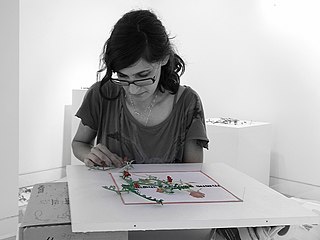JoAnn Giordano is an American textile artist and curator who has exhibited since 1977.

Claire Zeisler was an American fiber artist who expanded the expressive qualities of knotted and braided threads, pioneering large-scale freestanding sculptures in this medium. Throughout her career Zeisler sought to create "large, strong, single images" with fiber.

Sheila Hicks is an American artist. She is known for her innovative and experimental weavings and sculptural textile art that incorporate distinctive colors, natural materials, and personal narratives.

Mary Walker Phillips, was an American textile artist, author and educator. She revolutionized the craft of hand knitting by exploring knitting as an independent art form. Her hand-knit tapestries and other creative pieces are exhibited in museums in the U.S. and Europe. She was honored as a fellow by the American Craft Council (ACC) in 1978.
Olga de Amaral is a Colombian textile and visual artist known for her large-scale abstract works made with fibers and covered in gold and/or silver leaf. Because of her ability to reconcile local concerns with international developments, de Amaral became one of the few artists from South America to become internationally known for her work in fiber during the 1960s and ‘70s. She is also considered an important practitioner in the development of postwar Latin American Abstraction. She currently lives and works in Bogotá, Colombia.

June Claire Wayne was an American painter, printmaker, tapestry innovator, educator, and activist. She founded Tamarind Lithography Workshop (1960–1970), a then California-based nonprofit print shop dedicated to lithography.

Goshka Macuga is an artist based in London. She was one of the four nominees for the 2008 Turner Prize.

Leza Marie McVey (1907–1984) was an American ceramist and weaver. She is known for her large hand-built organic forms.

Anne Wilson is a Chicago-based visual artist. Wilson creates sculpture, drawings, Internet projects, photography, performance, and DVD stop motion animations employing table linens, bed sheets, human hair, lace, thread and wire. Her work extends the traditional processes of fiber art to other media. Wilson is a professor in the Department of Fiber and Material Studies at The School of the Art Institute of Chicago.

Marianne Strengell was an influential Finnish-American Modernist textile designer in the twentieth century. Strengell was a professor at Cranbrook Academy of Art from 1937 to 1942, and she served as department head from 1942 to 1962. She was able to translate hand-woven patterns for mechanized production, and pioneered the use of synthetic fibers.

Catherine Elizabeth Cooke was an American designer principally known for her jewelry. She has been called "an icon within the tradition of modernist jewelry" and "a seminal figure in American Modernist studio jewelry". Her pieces have been shown nationally and internationally and are included in a number of museum collections, including the Museum of Modern Art (MOMA) in New York. She is regarded as an important role model for other artists and craftspeople.

Helena Hernmarck is a Swedish tapestry artist who lives and works in the United States. She is best known for her monumental tapestries designed for architectural settings.

The Franses Tapestry Archive and Library in London is devoted to the study of European tapestries and figurative textiles. It is the world’s largest academic research resource on the subject.

Dafna Kaffeman is an artist and a senior lecturer at the Bezalel Academy of Arts and Design. She works with glass and various materials and techniques such as embroidery, print, drawing, to produce what the David Owsley Museum of Art describes as "beautiful, crafted surfaces and disturbing text about aggressors and victims". She lives and works in Israel. Her work has appeared in solo and group exhibitions, and she has won, or been nominated for, a number of international prizes and awards.

Ruth Adler Schnee was a German-born American textile designer and interior designer based in Michigan. Schnee was best known for her modern prints and abstract-patterns of organic and geometric forms. She opened the Ruth Adler-Schnee Design Studio with her spouse Edward Schnee in Detroit, which operated until 1960. The studio produced textiles and later branched off into Adler-Schnee Associates home decor, interiors, and furniture.

Minna Carolina Mathilde Louise "Loja" Gesellius was a Finnish-American textile artist and sculptor. She founded the weaving department at the Cranbrook Academy of Art in Michigan. She also led her own studio, the Studio Loja Saarinen, which designed many of the textiles used in buildings designed by her husband, the architect Eliel Saarinen.
Joan Livingstone is an American contemporary artist, educator, curator, and author based in Chicago. She creates sculptural objects, installations, prints, and collages that reference the human body and bodily experience.
Nelly Homi Sethna was an Indian weaver, textile designer, researcher, writer and a crafts activist. She worked on the crossroads of Scandinavian modernism and Indian crafts tradition, which shaped her guiding philosophy. Her close association with Kamaladevi Chattopadhyay played an important role in the revival and promotion of traditional Indian crafts.

Jenny Hladíková was a Czech printmaker, painter and author of tapestries.
Qualeasha Wood is an American textile artist. Her work often deals with representation of African-American women in internet culture.















